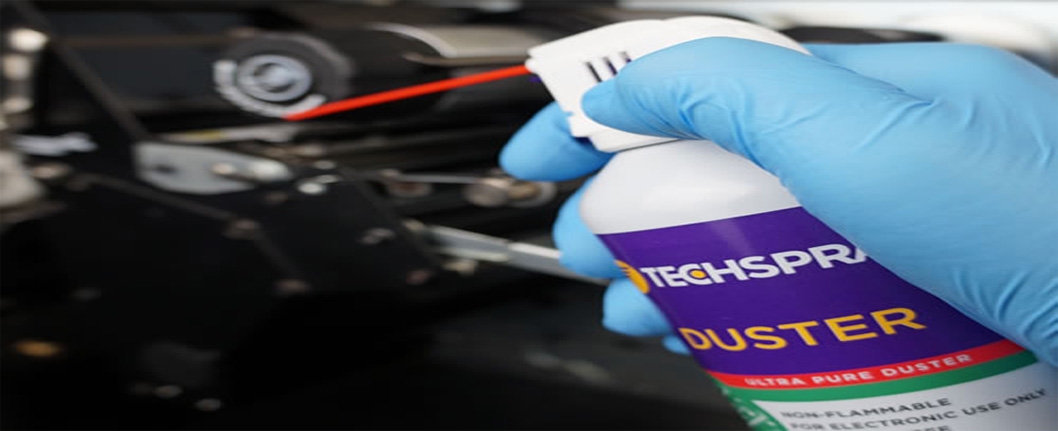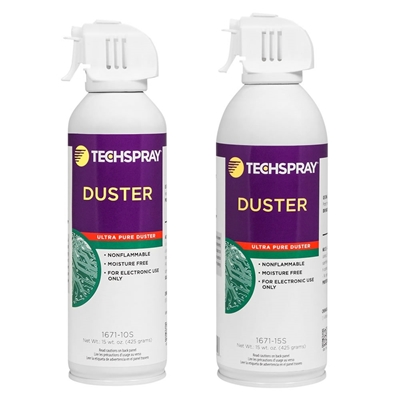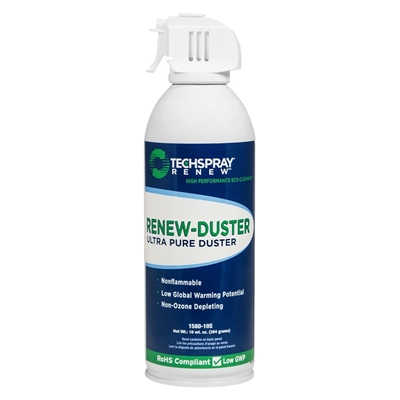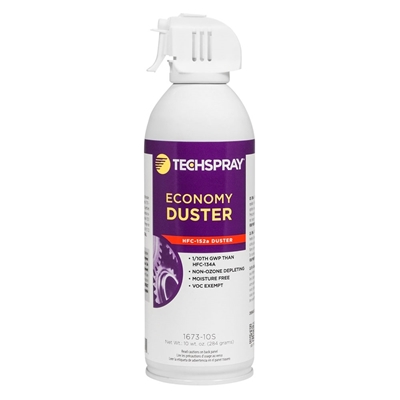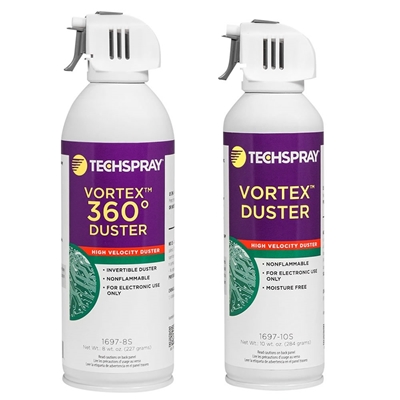Air Duster, also called “canned air”, “compressed air”, and “dusting gas”, is used to provide a pressurized blast, knocking loose dust and dirt. Think of it as a portable replacement for an air compressor line. This accessory can be used to blow cookie crumbs out from a keyboard, clear out computer vents, and even open up tight apertures in an SMT (surface mount technology) stencil in PCB assembly. It’s one of those products that seems simple, but leads people to many misconceptions. In this article, we’ll cover the most common questions and misconceptions about duster. If we missed your specific question, please leave us a comment below or contact us and we'll get it answered.
Air Duster is not “canned air”
Most aerosol duster contains a refrigerant/propellant that cannot be considered “air”. As a matter of fact, inhaling too many of these vapors can lead to negative health effects. Compressed Air Duster is most commonly filled with the following propellants:
- HFC-134a – Nonflammable, most common for industrial applications when spraying energized circuits because of the risk of a spark lighting a flammable material. It is under close scrutiny because it has a Global Warming Potential (GWP) of 1400 -- 1400 times the impact of CO2. On the back label, look for “1,1,1,2-Tetrafluoroethane” or CAS #811-97-2.
- HFC-152a – Most commonly available duster in consumer retail because it is less expensive than HFC-134a. It is flammable, and will ignite when concentrated (i.e. in liquid form) and exposed to a spark or flame. HFC-152a has the advantage of a lower GWP (130) than HFC-134a. On the back label, look for “1,1-difluoroethane” or CAS #75-37-6.
- HFO-1234ze – This is a newer, nonflammable material introduced in the last 10-years as a very low GWP alternative (<1) to HFC-134a. It is non-flammable and is almost indistinguishable from HFC-134a when sprayed, but unfortunately at a much higher price. On the back label, look for “trans- 1,3,3,3-Tetrafluoropropene” or CAS #29118-24-9.
- CO2 - It's not as common because the spray force is not consistent. Because of the higher pressure, it comes in small, low capacity cartridges. The spray force diminishes as the cartridge empties. On the back label, look for “carbon dioxide” or CAS #124-38-9.
- DME – DME is rarely used and in many areas cannot be legally used because of safety and environmental concerns. DME is extremely flammable and is a VOC (volatile organic compound), which can contribute to smog. All of the other duster alternatives do not contain VOCs. On the back label, look for “Dimethyl ether” or CAS #115-10-6.
Industrial Duster Is Not The Same As Retail/Consumer Duster
Customers looking for the lowest price often look to consumer retailers. Consumer duster is designed to be as cheap as possible, sometimes imported from outside the US. However, it isn’t designed for industrial use and may raise concerns:
- Retail duster generally contains HFC-152a – Look on the back of a can of aerosol hairspray, and you’ll generally find propane (the same propane as in your gas grill) or butane (the same butane in a Bic lighter). These chemicals are used because they are cheap, not because they are safe. In industrial markets, safety is a top concern, with careful oversight by OSHA (in the US specifically). Because of this, HFC-134a is more widely accepted in industrial markets, even at its higher price.
- Purity can be questionable – Industrial buyers rely on trusted industrial brands because the quality is closely controlled. The material is highly filtered and controls are implemented to avoid moisture and other contamination.
- Additives to prevent huffing – Many retail dusters have bitterant added to prevent huffing. When duster is used in the home, there is concern that the material will be purposely inhaled (called “huffing” or “dusting”) by minors, which can sometimes lead to tragic consequences. To avoid this, bitterant is added to make the duster taste bad. This same bitterant can lead to unwanted and potentially harmful residues on sensitive surfaces like electronic circuit boards.
- Check fill weight – Retail duster can come in a variety of fill weights (the content of the material in a can) including 3.5 oz., 8 oz., 10 oz., and larger. This metric can only be accurately judged by the label since the size of the spray can may not vary.

Duster Doesn't Hurt The Ozone Layer
There is a misconception based on old information that dusters hurt the ozone layer. Dusters contained CFC’s over 20-years ago, but have since been replaced with materials that do not impact the ozone layer.
What Are The Additional Features of Aerosol Dusters?
- High spray force – Each type of Techspray has the potential to produce a certain amount of force. HFC-134a has the greatest potential, HFC-152a next, and HFO-1234ze a distant third. In approximate terms, the HFC-152a has about 10% less potential to generate force compared to HFC-134a, and the HFO-1234ze has about 33% less potential to generate force compared to HFC-134a. Techspray offers duster products with even higher spray force by controlling output through both the valving and the sprayer. Vortex Duster generates about 60% more force compared to other HFC-134a dusters.
- Invertible – Due to the aerosol duster valving design, they generally can only be sprayed right-side-up or, at most, a 45º angle. Under high pressure, the propellant is mostly liquid, with the empty part of the can filled with vapor. When you spray an aerosol duster, the vapors of the propellant are expelled. As you rotate the can, the liquid starts to spray out and at a very low temperature (as low as -60ºF / -51.5ºC). Techspray® offers Vortex 360, which is specifically designed to spray only gas as you rotate the can. As a side note, this also explains why it is a bad idea to shake up a can of duster before use, as is the habit of using spray paint. If you shake the duster, the liquid propellant is more likely to sputter out as you start spraying.
- Chrome trigger/refill cans – Some dusters include a chrome trigger sprayer and a refill can with a threaded valve. These components allow you to reuse the sprayer and purchase refill cans. The advantage of the chrome sprayer is more precise control over spray force and ESD (electrostatic discharge) control. The standard plastic sprayer has the potential to build up a static charge as you spray. The chrome trigger is conductive, so it will not build up a charge, and it has the potential to be grounded. For example, if the user is grounded by a wrist strap, the sprayer and can be grounded as well if in good contact with the person’s hand.
What’s The Correct Technique for Dusting?
To achieve the optimum force from a can of duster, spray a short three to five-second blast at room temperature. When an aerosol duster is sprayed continuously, it acts as an efficient heat sink and will cool down. This lowering of the can temperature also lowers the internal pressure of the can, which will greatly decrease the generated force.
What Are Some Alternatives to Aerosol Dusters?
- Shop air – In an industrial setting, dropping an airline is very common. In this case, a compressor constantly keeps the line pressurized with air. It can be an economical way to blow off dust, dirt, and other contaminants, but the downside is that you are tethered by the airline. This extension becomes impractical during field work or in-house work that requires more flexibility. In addition, contamination can be brought through the airline from either ambient air or oil from the compressor.
- Mechanical dusters – Plug-in or battery-operated dusters are available. They can offer savings compared to aerosol dusters, which must be replaced after each can is spent. However, the actual spray force from mechanical dusters can be as low as 60-70% less than an aerosol duster, and they can be as loud as 90 kB (similar to the volume of a lawnmower).
- Bulb dusters – Photographers will be familiar with the bulb-type blowers that are often used for lens cleaning. These may be an economical solution for very light dust, but the force generated is a small fraction of that generated by aerosol dusters.
As the above details demonstrate, care needs to be taken even when choosing an everyday consumable like a duster. Reach out to us or your distributor for help deciding which duster is right for your application.

